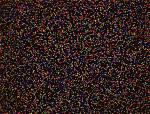One problem with this procedure is that the light coming out of a single molecule may not be bright enough to see. The main solution to this problem is to make many copies of the original ssDNA so the chemical reactions and the light will be repeated by many molecules, like this:
5′-ACCGTACGTTGC-3′
………….......…..3′-G-5′
5′-ACCGTACGTTGC-3′
………….......…..3′-G-5′
5′-ACCGTACGTTGC-3′
………….......…..3′-G-5′
5′-ACCGTACGTTGC-3′
………….......…..3′-G-5′
5′-ACCGTACGTTGC-3′
………….......…..3′-G-5′
5′-ACCGTACGTTGC-3′
....………………3′-CG-5′
5′-ACCGTACGTTGC-3′
....………………3′-CG-5′
5′-ACCGTACGTTGC-3′
....………………3′-CG-5′
5′-ACCGTACGTTGC-3′
....………………3′-CG-5′
5′-ACCGTACGTTGC-3′
....………………3′-CG-5′
And so on.
This means that sometimes errors can happen. We get a mixture of light that may confuse detection. For example:
5′-ACCGTACGTTGC-3′
………….......…..3′-G-5′
5′-ACCGTACGTTGC-3′
………….......…..3′-G-5′
5′-ACCGTACGTTGC-3′
………….......…..3′-G-5′
5′-ACCGTACGTTGC-3′
………….......…..3′-G-5′
5′-ACCGTACGTTGC-3′
………….......…..3′-C-5′
In the last string, the letter C was synthesized instead of G. This is rare, but it can happen.
Because errors can accumulate over each step of the process it becomes harder to tell the colors apart as the synthesized strings become longer. This limits the length of the string that can be read accurately at any given time. Currently, we can read about 150 nucleotides at a time.


 Discovering the Genome
Discovering the Genome